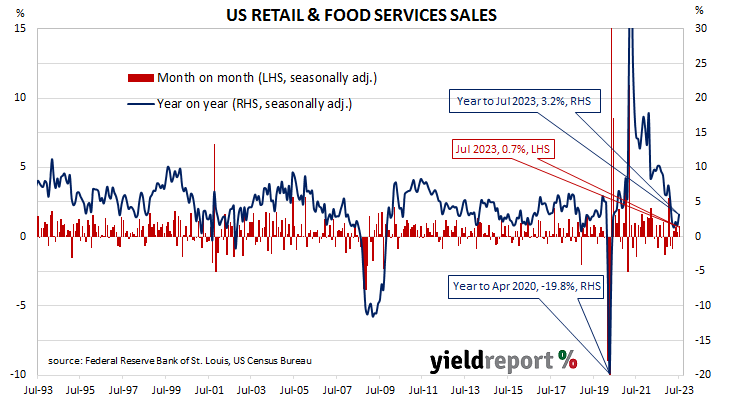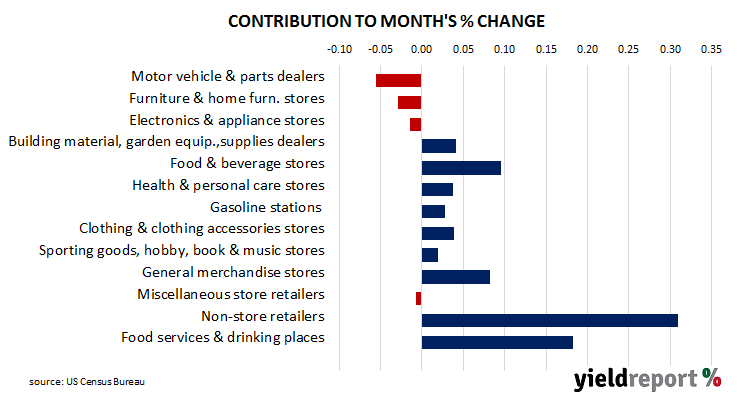Summary: US retail sales up 0.7% in July, more than expected; annual growth rate speeds up to 3.2%; ANZ: sub-category used for calculating GDP rises 1.0%; long-term Treasury yields rise; rate-cut expectations unchanged; NAB: possible shifts in timing of Amazon Prime Day playing havoc with seasonal adjustment process; higher sales in nine of thirteen retail categories; online segment again largest single influence on month’s result
US retail sales had been trending up since late 2015 but, commencing in late 2018, a series of weak or negative monthly results led to a drop-off in the annual growth rate below 2.0%. Growth rates then increased in trend terms through 2019 and into early 2020 until pandemic restrictions sent it into negative territory. A “v-shaped” recovery then took place which was followed by some short-term spikes as federal stimulus payments hit US households in the first and second quarters of 2021.
According to the latest “advance” numbers released by the US Census Bureau, total retail sales increased by 0.7% in July. The result was more than the 0.4% increase which had been generally expected as well as June’s 0.3% rise after it was revised up from 0.2%. On an annual basis, the growth rate sped up from June’s revised rate of 1.6% to 3.2%.
“Control group sales, a sub-category which is used in calculating GDP, rose 1.0% versus 0.5% in June and expectations of [a] 0.5% gain,” said ANZ economist Kishti Sen. “The 3-month average of control group sales is 0.7%, which is more than double the long run pre-COVID average of 0.3%”.
Long-term US Treasury bond yields increased on the day. By the close of business, the 2-year Treasury yield had returned to its starting point at 4.96% while 10-year and 30-year yields both finished 3bps higher at 4.22% and 4.32% respectively.
In terms of US Fed policy, expectations of a lower federal funds rate in the first half of 2024 barely changed. At the close of business, contracts implied the effective federal funds rate would average 5.34% in September, slightly above the current spot rate, and then average 5.355% in October. December futures contracts implied a 5.415% average effective federal funds rate while August 2024 contracts implied 4.78%, 55bps less than the current rate.
“It’s possible, some US data analysts note, that shifts in the timing of Amazon Prime Day is playing havoc with the seasonal adjustment process but that may be clutching at straws in looking for evidence that the US consumer has significantly slowed their spending habits,” observed NAB Head of FX Strategy Ray Attrill.
Nine of the thirteen categories recorded higher sales over the month. The “Non-store retailers” segment again provided the largest single influence on the overall result, rising by 1.9% over the month and contributing 0.31 percentage points to the total.
The non-store segment includes vending machine sales, door-to-door sales and mail-order sales but nowadays this segment has become dominated by online sales. It now accounts for nearly 17% of all US retail sales and it is the second-largest segment after vehicles and parts.



